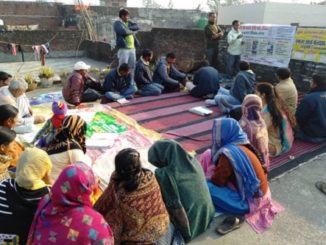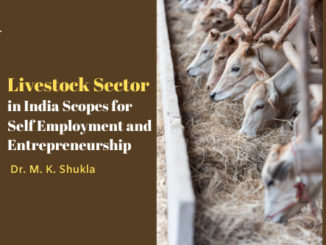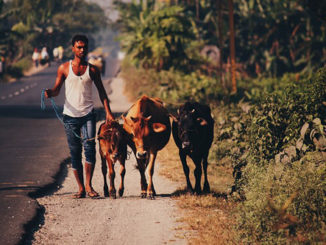Introduction
Animal husbandry refers to livestock raising and selective breeding. It is the management and care of animals in which the genetic qualities and behavior of animals are further developed for profit. India’s livestock sector is one of the largest in the world. About 20.5 million people depend upon livestock for their livelihood. Livestock contributed 16% to the income of small farm households as against an average of 14% for all rural household. Livestock provides livelihood to two-third of rural community. It also provides employment to about 8.8 % of the population in India has vast livestock resources. Livestock sector contributes 4.11% GDP and 25.6% of total Agriculture GDP. Economic Survey 2020 noted that livestock sector has grown at a compound annual growth rate of 9 per cent during last five years. As per the Economic Survey-2021, the contribution of Livestock in total agriculture and allied sector Gross Value Added (at Constant Prices) has increased from 32% (2014-15) to 28.63% (2018-19). Livestock income has become an important secondary source of income for rural families and has assumed an important role in achieving the goal of doubling farmers’ income.
Major Animal Husbandry Development Programs in India
- Military Dairy Farm (Allahabad), 1889
- First Census of Cattle, 1919
- Premium Bull Scheme, 1928
- Anand Milk Union Limited (AMUL), 1946
- Central Herd Registration Scheme (CHRS), 1949
- Central Goshala Development Board (CGDB), 1949
- Central Council of Gosamvardhana (CCG), 1952
- Key Village Scheme (KVS), 1952
- Hill Cattle Development Scheme, 1955
- Progeny Testing Scheme, 1960
- Indo-Swiss Project,1960
- Establishment of Sheep Breeding Farms 3rd Five Year Plan, 1960-65
- Indo-Danish Project 1964
- Intensive Cattle Development Programme (ICDP), 1964
- National Dairy Development Board (NDDB), 1965
- All India Co-ordinated Research Project (AICRP) on Cattle 1968
- Sheep and Wool Extension and Grading Centres (4th FYP ), 1969-74
- Operation Flood Phase I – 1970-80 Phase II – 1981-85 Phase III – 1986-96
- Dairy Herd Improvement Action (DIPA) Programme,1970
- Open Nucleus Breeding Scheme (ONBS), 1970
- National Milk Grid (NMG) (by NDDB), 1970
- National Milch Herd (NMH) (by NDDB), 1970
- AICRP on Buffalo, 1970
- AICRP on Poultry Meat and Eggs, 1970
- National Co-operative Dairy Federation of India (NCDF), 1970
- AICRP on Sheep and Goat ,1971
- National Co-operative Development Corporation, 1972
- Special Livestock Breeding Programme (SLBP), 1976
- Fish Farmers Development Agency FFDA, 1976
- Decade of Poultry in India 6th and 7th FYP, 1980-90
- National Project on Biogas Development (Now known as National Biogas and Manure Management Programme, 1981
- National Egg Coordination Committee (NECC) May, 1982
- Technology Mission on Dairy Development (TMDD), 1988
- Network Project on Sheep Improvement (NWPSI), 1990
- Network Project on Goat Improvement (NWPGI), 1990
- Deep Sea Fishing Policy, 1991
- Intensive Dairy Development Project (IDDP), 1992
- National Project on Rinderpest Eradication (NPRE), 1998
- National Policy for Cattle and Bovine Breeding (NPCBB), 2000
- Conservation of Threatened Breeds of Small Ruminants, Rabbits, Pigs, Pack Animals and Equines 2002
- Livestock Insurance Scheme (LIS), 2005
- Fodder and Feed Development Scheme, 2005
- National Fisheries Development Board (NFDB), 2006
- Intensive Dairy Development Programme (IDDP), 2006
- Intensive Poultry Development Project, 2006
- Dairy Entrepreneurship Development Scheme (DEDS), 2010
- Pig Development Scheme, 2010
- Integrated Development of Small Ruminants and Rabbits (IDSRR), 2010
- Utilization of Fallen Animals 2010
- Salvaging and Rearing of Male Buffalo Calves (SRMB), 2010
- National Mission for Protein Supplements, 2011
- Accelerated Fodder Development Programme, 2011
- National Dairy Plan (NDP) (by NDDB), 2012
- National Livestock Policy (NLP), 2013
- National Livestock Mission (NLM), 2014
- National Policy for Bovine Breeding and Dairy Development (NPBBDD), 2014
- Rashtriya Gokul Misson (RGM), 2014
- National Mission on Bovine Productivity (NMBP), 2016
- GOBAR (Galvanizing Organic Bio-Agro Resources) – Dhan Scheme, 2018
Animal Husbandry Development Program Under Five Year Plans
First Five-Year Plan
- Community development program/KVS.
- Increase of milk production & supply to urban.
- Improve the quality of indigenous.
- Official cattle breeding policies was laid.
- Buffalo was introduced in key village.
- Go-sadans were set up for surplus.
Second Five-Year Plan
- Set-up of pedigree bull rearing farm for progeny testing in KVS area.
- Establishment of 196 key village.
- 670 A.I. centers, 34 new gosadans & 248 goshalas, 1900 veterinary dispensaries were started.
- Establishment of daily milk supply chain
- Private enterpreneure like Glaxo, Liver, Nestle started their milk product processing plant.
Third Five-Year Plan
- Setting up fodder
- Encouraged cross-breeding with exotic breed.
- Manufacturing of dairy machines & equipment in private sector.
- Intensive cattle development project was started.
- 143 urban milk-boards & milk-plants have been established.
- Preparation of feed by using agricultural waste and by-products.
Fourth Five-Year Plan
- Selective breeding program was initiated.
- International linkage of the development strategies through dairy commodity under world Food
- Dairy development started in Karnataka, M.P. & few other state.
- Operation flood.
- AICRP
Fifth Five-Year Plan
- aggressive cross-breeding.
- Import of exotic semen doses,bulls, heifers of exotic breed.
- Exotic cattle breeding program.
- Large scale integrated dairy development projects were started.
Sixth Five-Year Plan
- Increasing the population of bovine by replacing non-descript local stock.
- 500 key village schemes & 122 ICD projected were started.
- Establishment of frozen semen station.
- Institute of buffalo research was established.
Seventh Five-Year Plan
- Bring almost 50% cows under cross-breeding
- Set a target of 5.6% annual growth in milk
- Embryo transfer technology were
- Operation flood phase 2nd
- PTS was
Eight Five-Year Plan
- Milk & milk product order was issued.
Ninth Five-Year Plan
- Effective animal health management to reduce economic losses.
- Enlarge export of livestock.
- Per capita availability of milk reached to 226 gram/day.
- Sanitary & Phyto-sanitary measures (SPS).
Tenth Five-Year Plan
- Target of the milk production is set to 108.4 MT at 6% annual growth rate.
- National project on cattle & buffalo improvement.
- Genetic up-gradation of indigenous breed.
- Expending the A.I. & natural service network.
- Holistic approach to clean milk production
- Conservation of fodder into feed block to facilitate transport of fodder from surplus areas to fodder deficit areas.
- Establishment of fodder bank
- Complete eradication of rinder-pest.
- Adoption of natural immunization.
- Increase fodder production by using intensive fodder production technique.
- Implementation of all India control of animal disease
Eleventh Five-Year Plan
- Adequate availability of quality fodder is essential for enhancing livestock productivity. For this, there is need to target at least ten percent of the cultivable land for growing fodder.
- The National Cattle and Buffalo Breeding Project (NCBBP) would continue to the major initiative in cattle and buffalo development. Emphasis would be on using only quality semen.
- NDDB is setting up a consortorium with NABARD and NCDC to fund the dairy sector.
- National Agricultural Development Programme (NADP).
- National Project for Cattle and Buffalo Breeding (NPCBB).







Be the first to comment